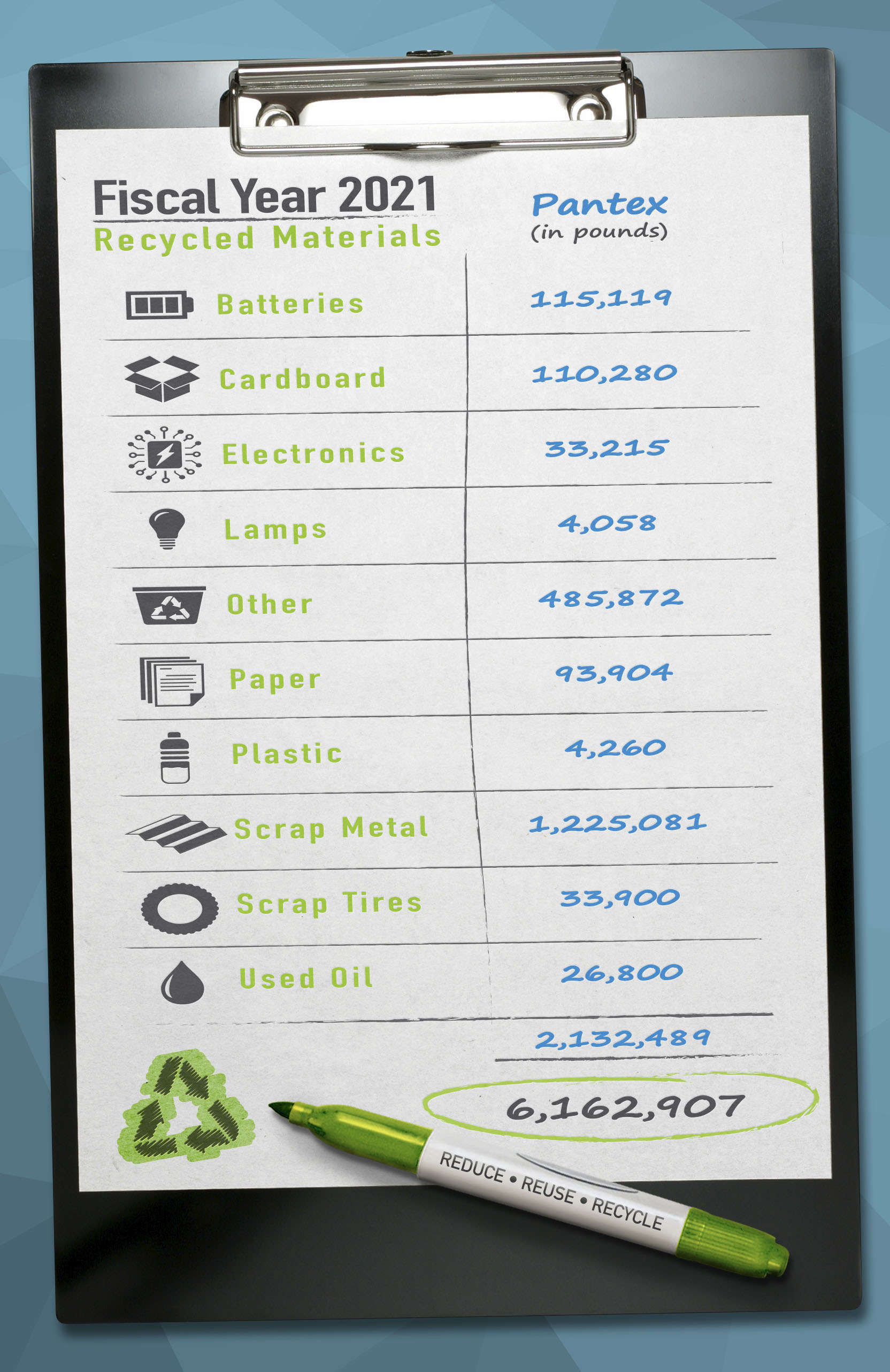7 Ways Pantex Protects the Environment
The Pantex Wind Farm has allowed the site to consistently exceed DOE goals regarding the use of renewable energy and reduce energy-related greenhouse gas emissions.
Pantex and Y-12 are committed to policies and practices that help protect the environment.
Those commitments can be summed up with the acronym P2C2:
- Protect the environment,
- Prevent pollution,
- Comply with applicable legal and other requirements, and
- Continual improvement.
Pantex carries out these promises on a daily basis. Here are seven ways Pantex works to help the environment.
Employing renewable energy
Since the summer of 2014, the Pantex Renewable Energy Project (PREP) has allowed the site to consistently exceed DOE goals for using renewable energy and reducing energy-related greenhouse gas emissions. The wind farm also provides both Pantex and Y-12 with renewable energy credits, which help exceed DOE sustainability goals. PREP was recently featured by DOE as the largest federal wind farm in America. Pantex also continues to use renewable energy-powered equipment such as solar-powered aerators in the wastewater lagoons, solar-powered lights at parking lots, and solar-generated power to emergency notification towers.
Buying Green
Pantex continues the tradition of acquiring products that are environmentally sustainable. During FY 2021, Pantex received the Electronic Product Environmental Assessment Tool (EPEAT) Purchaser Award for purchasing approximately 95% of monitors, computers, telephones, televisions, and other imaging systems that met the EPEAT criteria established by the Green Electronics Council. Nearly 100% of all computers and monitors save energy by using power management tools. Pantex also received the 2021 DOE Office of Sustainable Environmental Stewardship Silver Level Greenbuy Award for purchasing six green priority products in four different categories.
Recycling to prevent waste

During FY 2021, Pantex recycling efforts resulted in a total 2,132,489 pounds in recycled material. The following quantities (in pounds) of waste were shipped to various recycling companies:
- Batteries 115,119
- Cardboard 110,280
- Electronics 33,215
- Lamps 4,058
- Other 485,872
- Paper 93,904
- Plastic 4,260
- Scrap Metal 1,225,081
- Scrap Tires 33,900
- Used Oil 26,800
Reducing energy intensity
Pantex continues to work to reduce energy intensity by 20%, primarily through the use of the Pantex wind farm. Energy intensity is the amount of energy used per square foot of plant’s footprint. By 2025, the goal is to reduce energy intensity at Pantex by 30% from the 2015 baseline. Energy savings in projects such as the heating, ventilation, and air conditioning (HVAC) replacements and security lighting upgrades will further Pantex’s progress in reducing energy consumption.
Conserving water resources
The groundwater remediation program at Pantex focuses on pumping water from the perched aquifer and limiting the amount of recharge back into the perched aquifer. When contaminated water is pumped from the perched aquifer, it is treated to remove contaminants. This treated groundwater is then mixed with treated wastewater from the rest of the plant. Over the last two years, Pantex has renovated a subsurface irrigation system that, under a permit from the State of Texas, allows this treated wastewater to be beneficially reused for crop irrigation. Using the treated wastewater for irrigation increases crop production and reduces the amount of recharge going back into to the perched aquifer. During the crop growing season, between 900,000 and 1 million gallons of treated wastewater may be used in the subsurface irrigation system for the purpose of beneficial reuse. To supplement the subsurface irrigation system, Pantex is constructing a five-pivot irrigation system on Pantex property east of FM 2373. Similar to the subsurface system, the pivots will receive treated water from the plant wastewater facility and the groundwater pump and treat systems to be reused for surface irrigation of crops.
Following the rules
The State of Texas has issued Pantex an environmental compliance rating of “high,” which is the best rating that is offered by the state. The rating is based on Pantex’s compliance with its permits and authorizations and all of the environmental laws and regulations applicable to its operations. In addition, the state has classified the Pantex water supply and distribution system as “superior.” This is also the highest rating offered by the state and is based on performing operations that go beyond those required by regulation.
Reducing waste
Pantex continues to use digital technology, such as the X-ray machine in the Pantex Occupational Medical Department, to eliminate silver-contaminated film wastes and reduce annual radiography waste. Electronics equipment is dispositioned through certified recyclers, transferred, or donated to other sites and/or educational institutions through various government programs. Accordingly, 99% of electronic equipment was kept out of landfills. In addition, more than 95% of all Pantex printers have duplex printing capabilities to save paper use.
